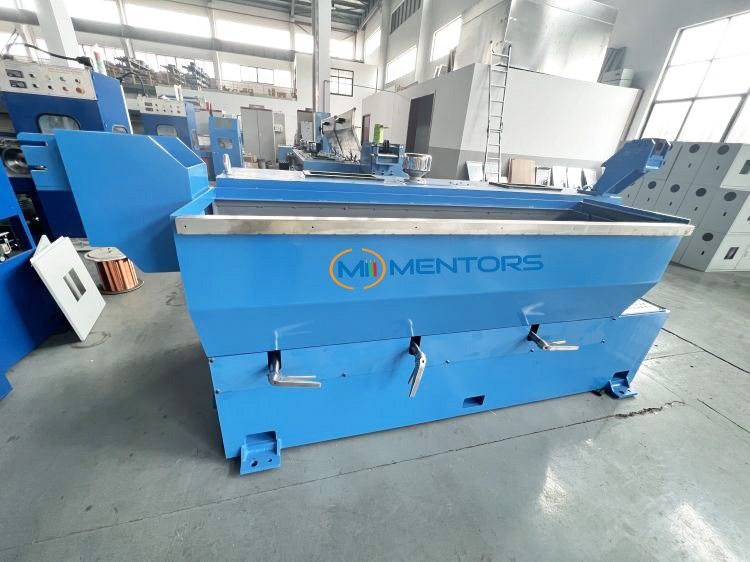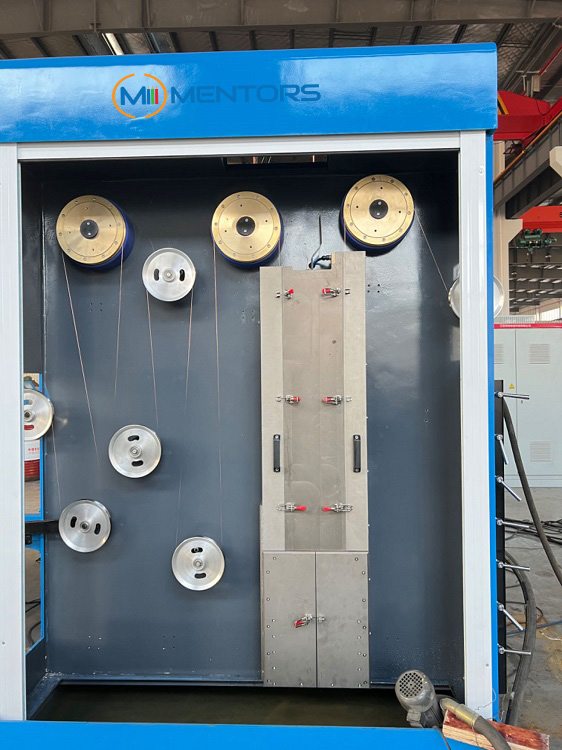1. Construction features:
1.1 Frame
The precise annealing frame is welded by a high-quality A3 steel plate.
1.2 Transmission part and electrode part
The annealing machine’s power is from the main machine. The electrode wheel is run by a flat belt. The tension is adjusted by pressing the wheel. Outlet speed is 0.3% faster than inlet speed, which can prevent the wire from getting thinner.
1.3 Carbon brush and electrode construction
High-density carbon brushes are used to prolong life. The electrode wheel and shaft are made of brass, the collector ring is made of phosphor bronze, and the guide wheel ring is made of pure nickel belt, which has good conductivity and long life. The electrode and the machine base are insulated with glass fiber bakelite.
1.4 Cooling part
Cooling liquid is supplied from the outer pool.
1.5 Electrical part
It is made up of an annealing control cabinet (including the transformer) and an electrode wheel.

2. The Annealing Part of Intermediate Wire Drawing Machine Working Principle :
2.1 After the wire is pulled out from the fixed speed wheel of the intermediate wire drawing main machine, it contacts the inner ring of the short circuit wheel through the steering wheel, and then contacts the upper contact wheel after passing through the reversing guide wheel (adjustable).
There are slip rings and carbon brushes at the back of the upper contact wheel, and the positive potential of the annealing DC power supply is introduced by the copper bar, so that there is a voltage at both ends of the line from the short circuit wheel to the upper contact wheel so that a current passes through and the copper wire is heated. This interval is the preheating section. Conductive slip rings and carbon brushes are also installed at the rear of the lower contact wheel shaft, and the negative potential of the DC power supply is introduced with a copper bar so that the wire between the upper and lower contact wheels passes through a larger current. In a very short time, the temperature of the wire rises to a very high level, while the lower contact wheel is soaked in the cooling liquid, and the wire enters the cooling liquid to cool at a high temperature so that the wire section can be softened. This section is the annealing section.
2.2 From the lower contact wheel to the short-circuit wheel is the drying section, and this section also has an electric current to heat the cooled wire again, so as to dry the cooling liquid brought out by the wire (three-stage annealing).
The level of annealing voltage is automatically tracked and changed according to the speed of the wire drawing, so as to ensure good annealing of the wire during starting and stopping during the wire drawing
2.3 The upper part of the annealing device is the annealing part of the wire, and the lower part is the coolant buffer tank. It is best to use an emulsion with a fat content of 0.5% to store the coolant. Adjust the water supply valve and the water discharge valve to keep the liquid level of the cooling wire at a certain height. The temperature of the coolant should be below 45ºC.
2.4 There is a wire blower near the short-circuit wheel in the drying section. When working, put pure and dry compressed air in the middle of the wire blower, so that the moisture of the wire after annealing can be blown dry. The machine needs steam or nitrogen protection, and it is connected through the equipment interface.

3. Common faults and troubleshooting methods
| Fault Name | Possible Reason | Exclusions |
| Intermediate Wire Drawing Machine can’t work | 1. The power switch is off
2. No reset when the machine stops for wire break and length break 3. The emergency button is on 4. Inverter fault |
1. Turn on the power switch
2. Just reset 3. Turn off the emergency button 4.1 According to the parameter on the inverter screen and the manual of the inverter, solve it. 4.2 Turn off the power switch, and restart after 30s |
| Wire break frequently | 1. Wrong die arrangement
2. Too high speed 3. Bad raw material 4. Metamorphic lubrication 5. Burrs on the bobbin 6. Pay-off is not smooth 7. Too high pay-off speed 8. Sticky wire on capstan |
1. Arrange the die according to the machine slip ratio.
2. Slowdown 3. Change raw material 4. Change lubrication 5. Use ethanol and sandpaper to clean the bobbin 6. Adjust the position of the pay-off stand 7. Enlarge inlet diameter or slowdown 8. Clean the capstan with alcohol |
| Wire break at a certain position | 1. Wrong slip ratio
2. Wrong die size 3. The dies and guide wheel are not in the same line |
1. Arrange the die according to the machine slip ratio
2. Repair or change die 3. Change the position of the dies |
|
Re-tension not rising |
The meter reset button is not pressed after changing the spools | Restart after pressing the meter reset button |
|
Traversing not good |
1. The width of the traversing is not adjusted properly
2. Traversing motor failure 3. The limit switch is in poor contact 4. Traversing speed |
1. Adjust the traversing width
2. Check the traversing motor and its circuit 3. Replace the limit switch 4. Adjust the traversing speed according to the drawn wire diameter and speed |
Some information about the Intermediate Wire Drawing Machine with Annealing produced by Mentors is shared here. If you are interested in this machine, you can contact us:sunman@mentorsmachinery.com
NOTE: All rights reserved, Reprinting is prohibited without permission.
